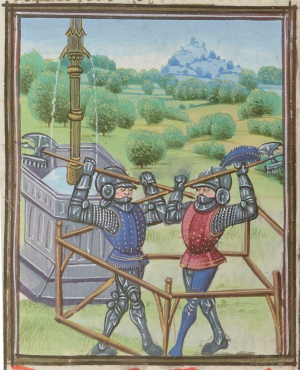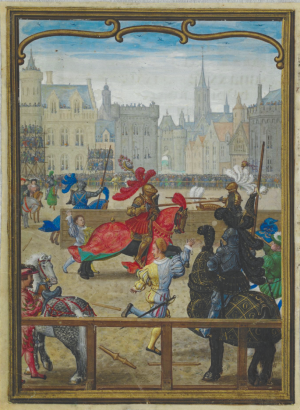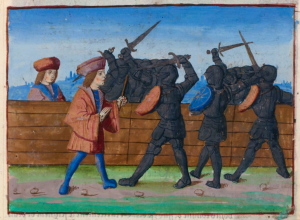The Joust as Performance: Pas d’armes and Late Medieval Chivalry
This project is financed by the Arts and Humanities Research Council (AHRC) based in the UK. It brings together an international research network of historians, art historians, literary scholars and museum professionals whose focus is on a multi-disciplinary analysis of the pas d’armes. The network’s primary purpose is to shed new light on this type of chivalric event that will be disseminated in a major volume of essays and translated sources aimed at students and specialists from a wide range of academic disciplines, as well as through an online database, a bibliography and a virtual exhibition that will be of interest to researchers, teachers, students and members of the public interested in chivalry.

From 2020 to 2023, the network held a series of nine online workshops at which it discussed methodology, analysed selected primary sources and planned its research and public engagement outputs. In July 2022, it organised a 3-day conference in Leeds where pre-circulated research papers were discussed. This conference was immediately followed by a Round Table at the Leeds International Medieval Congress that showcased the network’s various activities; this event attracted a lively audience, many of whom were postgraduates working on tournament culture, as well as material culture specialists and historians of different stripes.

In December 2023, the network launched its virtual exhibition on the pas d’armes. This exhibition is intended for a broad non-specialist audience and seeks to promote interest in this spectacular late medieval chivalric event. The exhibition guides the visitor from start to finish through the pas d’armes and consists of four spaces:
- Overview of the pas d'armes (typical features; inspirations; locations; motivations)
- Preparing for the event (permission and proclamation; rules of engagement; paying the bills)
- At the pas d’armes (typical stages of the event; personnel; arms, armour and fighting techniques; accompanying festivities)
- Aftermaths (textual commemorations; heraldry and armorials; authorial priorities; patrons and readers of narrative accounts, legacy).
In 2024, the network will publish Pas d’armes and Late Medieval Chivalry: A Casebook with Liverpool University Press. This volume will comprise an indicative selection of translated and contextualised primary sources on the pas d’armes that includes narrative texts, administrative accounts and images from manuscripts, as well as a glossary of arms and armour, clothing and textiles typically used at this kind of tournament. It will also contain seven new scholarly essays on the pas d’armes, addressing the issue of how this type of chivalric event evolved through cultural transfer from court to court, offering in-depth analyses of a chronological and geographical range of pas d’armes from the perspective of text-image relations, heraldry, urban-court relations and manuscript commissioning, and focusing on broader themes such as the construction of masculinity and the representation of chivalric and non-chivalric bodies at these events. A full bibliography of the primary, secondary and web-based sources cited in the Casebook is already available to download here.

Finally, in 2024, the network will also launch a research database containing information on the locations, organisers, participants and audiences of pas d’armes that were staged in Europe between c.1420 and c.1520.